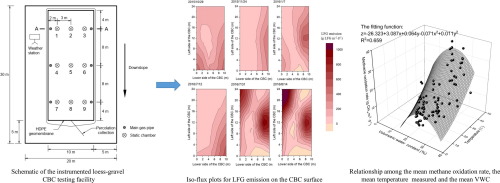当前位置:
X-MOL 学术
›
Waste Manag.
›
论文详情
Our official English website, www.x-mol.net, welcomes your feedback! (Note: you will need to create a separate account there.)
Full-scale experimental study of methane emission in a loess-gravel capillary barrier cover under different seasons.
Waste Management ( IF 8.1 ) Pub Date : 2020-04-07 , DOI: 10.1016/j.wasman.2020.03.026 Liang-Tong Zhan 1 , Tao Wu 1 , Song Feng 2 , Guang-Yao Li 1 , Hai-Jie He 3 , Ji-Wu Lan 1 , Yun-Min Chen 1
Waste Management ( IF 8.1 ) Pub Date : 2020-04-07 , DOI: 10.1016/j.wasman.2020.03.026 Liang-Tong Zhan 1 , Tao Wu 1 , Song Feng 2 , Guang-Yao Li 1 , Hai-Jie He 3 , Ji-Wu Lan 1 , Yun-Min Chen 1
Affiliation

|
The methane emission in a loess-gravel capillary barrier cover (CBC) in winter and summer was investigated by constructing a full-scale testing facility (20 m × 30 m) with a slope angle of 14.5° at a landfill in Xi'an, China. Weather conditions, methane emission, gas concentration, temperature, and volumetric water content (VWC) in the CBC were measured. The temperature and moisture in the CBC showed a typical seasonal pattern of warm and dry in summer and cold and wet in winter. Accordingly, the maximum methane oxidation rate and methane emission were higher in summer. The mean methane influx and methane emission decreased significantly as the VWC increased beyond 40% (i.e., a degree of saturation 0.85) at a depth of 0.85 m, which was near the loess/gravel interface. At this depth, more water was presented in the loess layer in the downslope direction due to capillary barrier effects, which increased the upslope methane emission. More dominant methane emission in the middle- and upper-section of the CBC occurred in summer than in winter as there was less soil moisture to facilitate methane transfer. The LFG balance showed that a significant fraction of the loaded LFG was not accounted in the flux chamber measurements due to the preferential flow along the edges of the CBC. The maximum methane oxidation rate was 93.3 g CH4 m-2 d-1, indicating the loess-gravel CBC could mitigate methane emissions after landfill closure.
更新日期:2020-04-08


























 京公网安备 11010802027423号
京公网安备 11010802027423号